数字通信系统的调制技术 翻译
- 格式:doc
- 大小:497.33 KB
- 文档页数:35
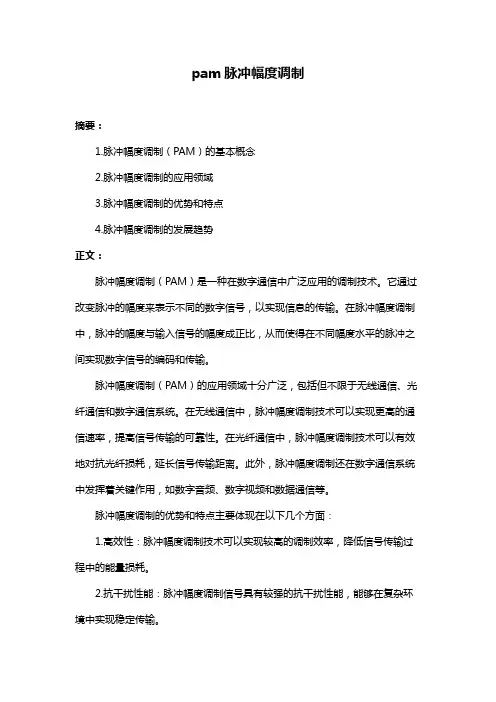
pam脉冲幅度调制摘要:1.脉冲幅度调制(PAM)的基本概念2.脉冲幅度调制的应用领域3.脉冲幅度调制的优势和特点4.脉冲幅度调制的发展趋势正文:脉冲幅度调制(PAM)是一种在数字通信中广泛应用的调制技术。
它通过改变脉冲的幅度来表示不同的数字信号,以实现信息的传输。
在脉冲幅度调制中,脉冲的幅度与输入信号的幅度成正比,从而使得在不同幅度水平的脉冲之间实现数字信号的编码和传输。
脉冲幅度调制(PAM)的应用领域十分广泛,包括但不限于无线通信、光纤通信和数字通信系统。
在无线通信中,脉冲幅度调制技术可以实现更高的通信速率,提高信号传输的可靠性。
在光纤通信中,脉冲幅度调制技术可以有效地对抗光纤损耗,延长信号传输距离。
此外,脉冲幅度调制还在数字通信系统中发挥着关键作用,如数字音频、数字视频和数据通信等。
脉冲幅度调制的优势和特点主要体现在以下几个方面:1.高效性:脉冲幅度调制技术可以实现较高的调制效率,降低信号传输过程中的能量损耗。
2.抗干扰性能:脉冲幅度调制信号具有较强的抗干扰性能,能够在复杂环境中实现稳定传输。
3.兼容性:脉冲幅度调制技术可以与其他调制技术相结合,实现多种通信系统的兼容和扩展。
4.灵活性:脉冲幅度调制技术可以根据实际应用需求,灵活调整信号参数,提高系统性能。
展望未来,脉冲幅度调制技术将继续发展,以适应不断变化的通信需求。
发展趋势包括:1.高比特率脉冲幅度调制:随着信息传输速率的不断提高,高比特率脉冲幅度调制技术将得到更广泛的应用。
2.宽带脉冲幅度调制:在光纤通信和无线通信领域,宽带脉冲幅度调制技术将有助于提高系统带宽利用率和信道容量。
3.集成化和模块化:随着半导体技术和微电子技术的进步,脉冲幅度调制电路将实现更高程度的集成化和模块化,降低系统成本。
4.智能化:未来,脉冲幅度调制技术将与其他智能技术相结合,实现自适应调制和优化算法,提高通信系统的性能。
总之,脉冲幅度调制(PAM)作为一种重要的调制技术,在数字通信领域具有广泛的应用前景。
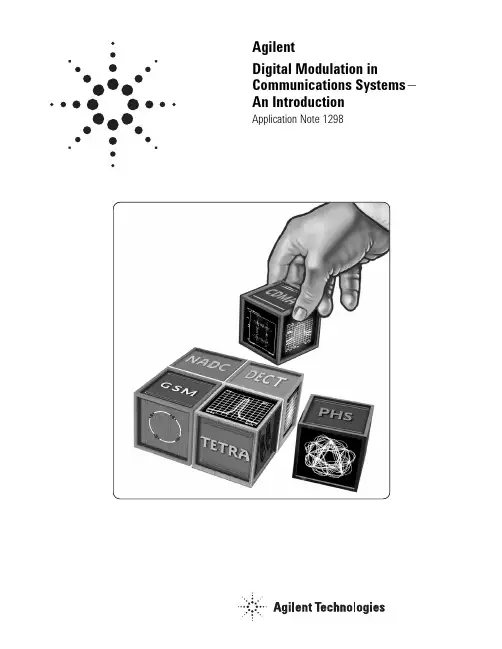
AgilentDigital Modulation in Communications Systems—An IntroductionApplication Note 1298This application note introduces the concepts of digital modulation used in many communications systems today. Emphasis is placed on explaining the tradeoffs that are made to optimize efficiencies in system design.Most communications systems fall into one of three categories: bandwidth efficient, power efficient, or cost efficient. Bandwidth efficiency describes the ability of a modulation scheme to accommodate data within a limited bandwidth. Power efficiency describes the ability of the system to reliably send information at the lowest practical power level.In most systems, there is a high priority on band-width efficiency. The parameter to be optimized depends on the demands of the particular system, as can be seen in the following two examples.For designers of digital terrestrial microwave radios, their highest priority is good bandwidth efficiency with low bit-error-rate. They have plenty of power available and are not concerned with power efficiency. They are not especially con-cerned with receiver cost or complexity because they do not have to build large numbers of them. On the other hand, designers of hand-held cellular phones put a high priority on power efficiency because these phones need to run on a battery. Cost is also a high priority because cellular phones must be low-cost to encourage more users. Accord-ingly, these systems sacrifice some bandwidth efficiency to get power and cost efficiency. Every time one of these efficiency parameters (bandwidth, power, or cost) is increased, another one decreases, becomes more complex, or does not perform well in a poor environment. Cost is a dom-inant system priority. Low-cost radios will always be in demand. In the past, it was possible to make a radio low-cost by sacrificing power and band-width efficiency. This is no longer possible. The radio spectrum is very valuable and operators who do not use the spectrum efficiently could lose their existing licenses or lose out in the competition for new ones. These are the tradeoffs that must be considered in digital RF communications design. This application note covers•the reasons for the move to digital modulation;•how information is modulated onto in-phase (I) and quadrature (Q) signals;•different types of digital modulation;•filtering techniques to conserve bandwidth; •ways of looking at digitally modulated signals;•multiplexing techniques used to share the transmission channel;•how a digital transmitter and receiver work;•measurements on digital RF communications systems;•an overview table with key specifications for the major digital communications systems; and •a glossary of terms used in digital RF communi-cations.These concepts form the building blocks of any communications system. If you understand the building blocks, then you will be able to under-stand how any communications system, present or future, works.Introduction25 5 677 7 8 8 9 10 10 1112 12 12 13 14 14 15 15 16 17 18 19 20 21 22 22 23 23 24 25 26 27 28 29 29 30 311. Why Digital Modulation?1.1 Trading off simplicity and bandwidth1.2 Industry trends2. Using I/Q Modulation (Amplitude and Phase Control) to Convey Information2.1 Transmitting information2.2 Signal characteristics that can be modified2.3 Polar display—magnitude and phase representedtogether2.4 Signal changes or modifications in polar form2.5 I/Q formats2.6 I and Q in a radio transmitter2.7 I and Q in a radio receiver2.8 Why use I and Q?3. Digital Modulation Types and Relative Efficiencies3.1 Applications3.1.1 Bit rate and symbol rate3.1.2 Spectrum (bandwidth) requirements3.1.3 Symbol clock3.2 Phase Shift Keying (PSK)3.3 Frequency Shift Keying3.4 Minimum Shift Keying (MSK)3.5 Quadrature Amplitude Modulation (QAM)3.6 Theoretical bandwidth efficiency limits3.7 Spectral efficiency examples in practical radios3.8 I/Q offset modulation3.9 Differential modulation3.10 Constant amplitude modulation4. Filtering4.1 Nyquist or raised cosine filter4.2 Transmitter-receiver matched filters4.3 Gaussian filter4.4 Filter bandwidth parameter alpha4.5 Filter bandwidth effects4.6 Chebyshev equiripple FIR (finite impulse response) filter4.7 Spectral efficiency versus power consumption5. Different Ways of Looking at a Digitally Modulated Signal Time and Frequency Domain View5.1 Power and frequency view5.2 Constellation diagrams5.3 Eye diagrams5.4 Trellis diagramsTable of Contents332 32 32 33 33 34 3435 35 3637 37 37 38 38 39 39 39 40 41 41 42 434344466. Sharing the Channel6.1 Multiplexing—frequency6.2 Multiplexing—time6.3 Multiplexing—code6.4 Multiplexing—geography6.5 Combining multiplexing modes6.6 Penetration versus efficiency7. How Digital Transmitters and Receivers Work7.1 A digital communications transmitter7.2 A digital communications receiver8. Measurements on Digital RF Communications Systems 8.1 Power measurements8.1.1 Adjacent Channel Power8.2 Frequency measurements8.2.1 Occupied bandwidth8.3 Timing measurements8.4 Modulation accuracy8.5 Understanding Error Vector Magnitude (EVM)8.6 Troubleshooting with error vector measurements8.7 Magnitude versus phase error8.8 I/Q phase error versus time8.9 Error Vector Magnitude versus time8.10 Error spectrum (EVM versus frequency)9. Summary10. Overview of Communications Systems11. Glossary of TermsTable of Contents (continued)4The move to digital modulation provides more information capacity, compatibility with digital data services, higher data security, better quality communications, and quicker system availability. Developers of communications systems face these constraints:•available bandwidth•permissible power•inherent noise level of the systemThe RF spectrum must be shared, yet every day there are more users for that spectrum as demand for communications services increases. Digital modulation schemes have greater capacity to con-vey large amounts of information than analog mod-ulation schemes. 1.1 Trading off simplicity and bandwidthThere is a fundamental tradeoff in communication systems. Simple hardware can be used in transmit-ters and receivers to communicate information. However, this uses a lot of spectrum which limits the number of users. Alternatively, more complex transmitters and receivers can be used to transmit the same information over less bandwidth. The transition to more and more spectrally efficient transmission techniques requires more and more complex hardware. Complex hardware is difficult to design, test, and build. This tradeoff exists whether communication is over air or wire, analog or digital.Figure 1. The Fundamental Tradeoff1. Why Digital Modulation?51.2 Industry trendsOver the past few years a major transition has occurred from simple analog Amplitude Mod-ulation (AM) and Frequency/Phase Modulation (FM/PM) to new digital modulation techniques. Examples of digital modulation include•QPSK (Quadrature Phase Shift Keying)•FSK (Frequency Shift Keying)•MSK (Minimum Shift Keying)•QAM (Quadrature Amplitude Modulation) Another layer of complexity in many new systems is multiplexing. Two principal types of multiplex-ing (or “multiple access”) are TDMA (Time Division Multiple Access) and CDMA (Code Division Multiple Access). These are two different ways to add diversity to signals allowing different signals to be separated from one another.Figure 2. Trends in the Industry62.1 Transmitting informationTo transmit a signal over the air, there are three main steps:1.A pure carrier is generated at the transmitter.2.The carrier is modulated with the informationto be transmitted. Any reliably detectablechange in signal characteristics can carryinformation.3.At the receiver the signal modifications orchanges are detected and demodulated.2.2 Signal characteristics that can be modified There are only three characteristics of a signal that can be changed over time: amplitude, phase, or fre-quency. However, phase and frequency are just dif-ferent ways to view or measure the same signal change. In AM, the amplitude of a high-frequency carrier signal is varied in proportion to the instantaneous amplitude of the modulating message signal.Frequency Modulation (FM) is the most popular analog modulation technique used in mobile com-munications systems. In FM, the amplitude of the modulating carrier is kept constant while its fre-quency is varied by the modulating message signal.Amplitude and phase can be modulated simultane-ously and separately, but this is difficult to gener-ate, and especially difficult to detect. Instead, in practical systems the signal is separated into another set of independent components: I(In-phase) and Q(Quadrature). These components are orthogonal and do not interfere with each other.Figure 3. Transmitting Information (Analog or Digital)Figure 4. Signal Characteristics to Modify2. Using I/Q Modulation to Convey Information72.3 Polar display—magnitude and phase repre-sented togetherA simple way to view amplitude and phase is with the polar diagram. The carrier becomes a frequency and phase reference and the signal is interpreted relative to the carrier. The signal can be expressed in polar form as a magnitude and a phase. The phase is relative to a reference signal, the carrier in most communication systems. The magnitude is either an absolute or relative value. Both are used in digital communication systems. Polar diagrams are the basis of many displays used in digital com-munications, although it is common to describe the signal vector by its rectangular coordinates of I (In-phase) and Q(Quadrature).2.4 Signal changes or modifications inpolar formFigure 6 shows different forms of modulation in polar form. Magnitude is represented as the dis-tance from the center and phase is represented as the angle.Amplitude modulation (AM) changes only the magnitude of the signal. Phase modulation (PM) changes only the phase of the signal. Amplitude and phase modulation can be used together. Frequency modulation (FM) looks similar to phase modulation, though frequency is the controlled parameter, rather than relative phase.Figure 6. Signal Changes or Modifications8One example of the difficulties in RF design can be illustrated with simple amplitude modulation. Generating AM with no associated angular modula-tion should result in a straight line on a polar display. This line should run from the origin to some peak radius or amplitude value. In practice, however, the line is not straight. The amplitude modulation itself often can cause a small amount of unwanted phase modulation. The result is a curved line. It could also be a loop if there is any hysteresis in the system transfer function. Some amount of this distortion is inevitable in any sys-tem where modulation causes amplitude changes. Therefore, the degree of effective amplitude modu-lation in a system will affect some distortion parameters.2.5 I/Q formatsIn digital communications, modulation is often expressed in terms of I and Q. This is a rectangular representation of the polar diagram. On a polar diagram, the I axis lies on the zero degree phase reference, and the Q axis is rotated by 90 degrees. The signal vector’s projection onto the I axis is its “I” component and the projection onto the Q axisis its “Q” component.Figure 7. “I-Q” Format92.6 I and Q in a radio transmitterI/Q diagrams are particularly useful because they mirror the way most digital communications sig-nals are created using an I/Q modulator. In the transmitter, I and Q signals are mixed with the same local oscillator (LO). A 90 degree phase shifter is placed in one of the LO paths. Signals that are separated by 90 degrees are also known as being orthogonal to each other or in quadrature. Signals that are in quadrature do not interfere with each other. They are two independent compo-nents of the signal. When recombined, they are summed to a composite output signal. There are two independent signals in I and Q that can be sent and received with simple circuits. This simpli-fies the design of digital radios. The main advan-tage of I/Q modulation is the symmetric ease of combining independent signal components into a single composite signal and later splitting such a composite signal into its independent component parts. 2.7 I and Q in a radio receiverThe composite signal with magnitude and phase (or I and Q) information arrives at the receiver input. The input signal is mixed with the local oscillator signal at the carrier frequency in two forms. One is at an arbitrary zero phase. The other has a 90 degree phase shift. The composite input signal (in terms of magnitude and phase) is thus broken into an in-phase, I, and a quadrature, Q, component. These two components of the signal are independent and orthogonal. One can be changed without affecting the other. Normally, information cannot be plotted in a polar format and reinterpreted as rectangular values without doing a polar-to-rectangular conversion. This con-version is exactly what is done by the in-phase and quadrature mixing processes in a digital radio. A local oscillator, phase shifter, and two mixers can perform the conversion accurately and efficiently.Figure 8. I and Q in a Practical Radio Transmitter Figure 9. I and Q in a Radio Receiver102.8 Why use I and Q?Digital modulation is easy to accomplish with I/Q modulators. Most digital modulation maps the data to a number of discrete points on the I/Q plane. These are known as constellation points. As the sig-nal moves from one point to another, simultaneous amplitude and phase modulation usually results. To accomplish this with an amplitude modulator and a phase modulator is difficult and complex. It is also impossible with a conventional phase modu-lator. The signal may, in principle, circle the origin in one direction forever, necessitating infinite phase shifting capability. Alternatively, simultaneous AM and Phase Modulation is easy with an I/Q modulator. The I and Q control signals are bounded, but infi-nite phase wrap is possible by properly phasing the I and Q signals.This section covers the main digital modulation formats, their main applications, relative spectral efficiencies, and some variations of the main modulation types as used in practical systems. Fortunately, there are a limited number of modula-tion types which form the building blocks of any system.3.1 ApplicationsThe table below covers the applications for differ-ent modulation formats in both wireless communi-cations and video. Although this note focuses on wireless communica-tions, video applications have also been included in the table for completeness and because of their similarity to other wireless communications.3.1.1 Bit rate and symbol rateTo understand and compare different modulation format efficiencies, it is important to first under-stand the difference between bit rate and symbol rate. The signal bandwidth for the communications channel needed depends on the symbol rate, not on the bit rate.Symbol rate =bit ratethe number of bits transmitted with each symbol 3. Digital Modulation Types and Relative EfficienciesBit rate is the frequency of a system bit stream. Take, for example, a radio with an 8 bit sampler, sampling at 10 kHz for voice. The bit rate, the basic bit stream rate in the radio, would be eight bits multiplied by 10K samples per second, or 80 Kbits per second. (For the moment we will ignore the extra bits required for synchronization, error correction, etc.)Figure 10 is an example of a state diagram of a Quadrature Phase Shift Keying (QPSK) signal. The states can be mapped to zeros and ones. This is a common mapping, but it is not the only one. Any mapping can be used.The symbol rate is the bit rate divided by the num-ber of bits that can be transmitted with each sym-bol. If one bit is transmitted per symbol, as with BPSK, then the symbol rate would be the same as the bit rate of 80 Kbits per second. If two bits are transmitted per symbol, as in QPSK, then the sym-bol rate would be half of the bit rate or 40 Kbits per second. Symbol rate is sometimes called baud rate. Note that baud rate is not the same as bit rate. These terms are often confused. If more bits can be sent with each symbol, then the same amount of data can be sent in a narrower spec-trum. This is why modulation formats that are more complex and use a higher number of states can send the same information over a narrower piece of the RF spectrum.3.1.2 Spectrum (bandwidth) requirementsAn example of how symbol rate influences spec-trum requirements can be seen in eight-state Phase Shift Keying (8PSK). It is a variation of PSK. There are eight possible states that the signal can transi-tion to at any time. The phase of the signal can take any of eight values at any symbol time. Since 23= 8, there are three bits per symbol. This means the symbol rate is one third of the bit rate. This is relatively easy to decode.Figure 10. Bit Rate and Symbol Rate Figure 11. Spectrum Requirements3.1.3 Symbol ClockThe symbol clock represents the frequency and exact timing of the transmission of the individual symbols. At the symbol clock transitions, the trans-mitted carrier is at the correct I/Q(or magnitude/ phase) value to represent a specific symbol (a specific point in the constellation).3.2 Phase Shift KeyingOne of the simplest forms of digital modulation is binary or Bi-Phase Shift Keying (BPSK). One appli-cation where this is used is for deep space teleme-try. The phase of a constant amplitude carrier sig-nal moves between zero and 180 degrees. On an I and Q diagram, the I state has two different values. There are two possible locations in the state dia-gram, so a binary one or zero can be sent. The symbol rate is one bit per symbol.A more common type of phase modulation is Quadrature Phase Shift Keying (QPSK). It is used extensively in applications including CDMA (Code Division Multiple Access) cellular service, wireless local loop, Iridium (a voice/data satellite system) and DVB-S (Digital Video Broadcasting — Satellite). Quadrature means that the signal shifts between phase states which are separated by 90 degrees. The signal shifts in increments of 90 degrees from 45 to 135, –45, or –135 degrees. These points are chosen as they can be easily implemented using an I/Q modulator. Only two I values and two Q values are needed and this gives two bits per symbol. There are four states because 22= 4. It is therefore a more bandwidth-efficient type of modulation than BPSK, potentially twice as efficient.Figure 12. Phase Shift Keying3.3 Frequency Shift KeyingFrequency modulation and phase modulation are closely related. A static frequency shift of +1 Hz means that the phase is constantly advancing at the rate of 360 degrees per second (2 πrad/sec), relative to the phase of the unshifted signal.FSK (Frequency Shift Keying) is used in many applications including cordless and paging sys-tems. Some of the cordless systems include DECT (Digital Enhanced Cordless Telephone) and CT2 (Cordless Telephone 2).In FSK, the frequency of the carrier is changed as a function of the modulating signal (data) being transmitted. Amplitude remains unchanged. In binary FSK (BFSK or 2FSK), a “1” is represented by one frequency and a “0” is represented by another frequency.3.4 Minimum Shift KeyingSince a frequency shift produces an advancing or retarding phase, frequency shifts can be detected by sampling phase at each symbol period. Phase shifts of (2N + 1) π/2radians are easily detected with an I/Q demodulator. At even numbered sym-bols, the polarity of the I channel conveys the transmitted data, while at odd numbered symbols the polarity of the Q channel conveys the data. This orthogonality between I and Q simplifies detection algorithms and hence reduces power con-sumption in a mobile receiver. The minimum fre-quency shift which yields orthogonality of I and Q is that which results in a phase shift of ±π/2radi-ans per symbol (90 degrees per symbol). FSK with this deviation is called MSK (Minimum Shift Keying). The deviation must be accurate in order to generate repeatable 90 degree phase shifts. MSK is used in the GSM (Global System for Mobile Communications) cellular standard. A phase shift of +90 degrees represents a data bit equal to “1,”while –90 degrees represents a “0.” The peak-to-peak frequency shift of an MSK signal is equal to one-half of the bit rate.FSK and MSK produce constant envelope carrier signals, which have no amplitude variations. This is a desirable characteristic for improving the power efficiency of transmitters. Amplitude varia-tions can exercise nonlinearities in an amplifier’s amplitude-transfer function, generating spectral regrowth, a component of adjacent channel power. Therefore, more efficient amplifiers (which tend to be less linear) can be used with constant-envelope signals, reducing power consumption.Figure 13. Frequency Shift KeyingMSK has a narrower spectrum than wider devia-tion forms of FSK. The width of the spectrum is also influenced by the waveforms causing the fre-quency shift. If those waveforms have fast transi-tions or a high slew rate, then the spectrumof the transmitter will be broad. In practice, the waveforms are filtered with a Gaussian filter, resulting in a narrow spectrum. In addition, the Gaussian filter has no time-domain overshoot, which would broaden the spectrum by increasing the peak deviation. MSK with a Gaussian filter is termed GMSK (Gaussian MSK).3.5 Quadrature Amplitude ModulationAnother member of the digital modulation family is Quadrature Amplitude Modulation (QAM). QAM is used in applications including microwave digital radio, DVB-C (Digital Video Broadcasting—Cable), and modems.In 16-state Quadrature Amplitude Modulation (16QAM), there are four I values and four Q values. This results in a total of 16 possible states for the signal. It can transition from any state to any other state at every symbol time. Since 16 = 24, four bits per symbol can be sent. This consists of two bits for I and two bits for Q. The symbol rate is one fourth of the bit rate. So this modulation format produces a more spectrally efficient transmission. It is more efficient than BPSK, QPSK, or 8PSK. Note that QPSK is the same as 4QAM.Another variation is 32QAM. In this case there are six I values and six Q values resulting in a total of 36 possible states (6x6=36). This is too many states for a power of two (the closest power of two is 32). So the four corner symbol states, which take the most power to transmit, are omitted. This reduces the amount of peak power the transmitter has to generate. Since 25= 32, there are five bits per sym-bol and the symbol rate is one fifth of the bit rate. The current practical limits are approximately256QAM, though work is underway to extend the limits to 512 or 1024 QAM. A 256QAM system uses 16 I-values and 16 Q-values, giving 256 possible states. Since 28= 256, each symbol can represent eight bits. A 256QAM signal that can send eight bits per symbol is very spectrally efficient. However, the symbols are very close together and are thus more subject to errors due to noise and distortion. Such a signal may have to be transmit-ted with extra power (to effectively spread the symbols out more) and this reduces power efficiency as compared to simpler schemes.Figure 14. Quadrature Amplitude ModulationCompare the bandwidth efficiency when using256QAM versus BPSK modulation in the radio example in section 3.1.1 (which uses an eight-bit sampler sampling at 10 kHz for voice). BPSK uses80 Ksymbols-per-second sending 1 bit per symbol.A system using 256QAM sends eight bits per sym-bol so the symbol rate would be 10 Ksymbols per second. A 256QAM system enables the same amount of information to be sent as BPSK using only one eighth of the bandwidth. It is eight times more bandwidth efficient. However, there is a tradeoff. The radio becomes more complex and is more susceptible to errors caused by noise and dis-tortion. Error rates of higher-order QAM systems such as this degrade more rapidly than QPSK as noise or interference is introduced. A measureof this degradation would be a higher Bit Error Rate (BER).In any digital modulation system, if the input sig-nal is distorted or severely attenuated the receiver will eventually lose symbol lock completely. If the receiver can no longer recover the symbol clock, it cannot demodulate the signal or recover any infor-mation. With less degradation, the symbol clock can be recovered, but it is noisy, and the symbol locations themselves are noisy. In some cases, a symbol will fall far enough away from its intended position that it will cross over to an adjacent posi-tion. The I and Q level detectors used in the demodulator would misinterpret such a symbol as being in the wrong location, causing bit errors. QPSK is not as efficient, but the states are much farther apart and the system can tolerate a lot more noise before suffering symbol errors. QPSK has no intermediate states between the four corner-symbol locations, so there is less opportunity for the demodulator to misinterpret symbols. QPSK requires less transmitter power than QAM to achieve the same bit error rate.3.6 Theoretical bandwidth efficiency limits Bandwidth efficiency describes how efficiently the allocated bandwidth is utilized or the ability of a modulation scheme to accommodate data, within a limited bandwidth. The table below shows the theoretical bandwidth efficiency limits for the main modulation types. Note that these figures cannot actually be achieved in practical radios since they require perfect modulators, demodula-tors, filter, and transmission paths.If the radio had a perfect (rectangular in the fre-quency domain) filter, then the occupied band-width could be made equal to the symbol rate.Techniques for maximizing spectral efficiency include the following:•Relate the data rate to the frequency shift (as in GSM).•Use premodulation filtering to reduce the occupied bandwidth. Raised cosine filters,as used in NADC, PDC, and PHS, give thebest spectral efficiency.•Restrict the types of transitions.Modulation Theoretical bandwidthformat efficiencylimitsMSK 1bit/second/HzBPSK 1bit/second/HzQPSK 2bits/second/Hz8PSK 3bits/second/Hz16 QAM 4 bits/second/Hz32 QAM 5 bits/second/Hz64 QAM 6 bits/second/Hz256 QAM 8 bits/second/HzEffects of going through the originTake, for example, a QPSK signal where the normalized value changes from 1, 1 to –1, –1. When changing simulta-neously from I and Q values of +1 to I and Q values of –1, the signal trajectory goes through the origin (the I/Q value of 0,0). The origin represents 0 carrier magnitude. A value of 0 magnitude indicates that the carrier amplitude is 0 for a moment.Not all transitions in QPSK result in a trajectory that goes through the origin. If I changes value but Q does not (or vice-versa) the carrier amplitude changes a little, but it does not go through zero. Therefore some symbol transi-tions will result in a small amplitude variation, while others will result in a very large amplitude variation. The clock-recovery circuit in the receiver must deal with this ampli-tude variation uncertainty if it uses amplitude variations to align the receiver clock with the transmitter clock. Spectral regrowth does not automatically result from these trajectories that pass through or near the origin. If the amplifier and associated circuits are perfectly linear, the spectrum (spectral occupancy or occupied bandwidth) will be unchanged. The problem lies in nonlinearities in the circuits.A signal which changes amplitude over a very large range will exercise these nonlinearities to the fullest extent. These nonlinearities will cause distortion products. In con-tinuously modulated systems they will cause “spectral regrowth” or wider modulation sidebands (a phenomenon related to intermodulation distortion). Another term which is sometimes used in this context is “spectral splatter.”However this is a term that is more correctly used in asso-ciation with the increase in the bandwidth of a signal caused by pulsing on and off.3.7 Spectral efficiency examples inpractical radiosThe following examples indicate spectral efficien-cies that are achieved in some practical radio systems.The TDMA version of the North American Digital Cellular (NADC) system, achieves a 48 Kbits-per-second data rate over a 30 kHz bandwidth or 1.6 bits per second per Hz. It is a π/4 DQPSK based system and transmits two bits per symbol. The theoretical efficiency would be two bits per second per Hz and in practice it is 1.6 bits per second per Hz.Another example is a microwave digital radio using 16QAM. This kind of signal is more susceptible to noise and distortion than something simpler such as QPSK. This type of signal is usually sent over a direct line-of-sight microwave link or over a wire where there is very little noise and interference. In this microwave-digital-radio example the bit rate is 140 Mbits per second over a very wide bandwidth of 52.5 MHz. The spectral efficiency is 2.7 bits per second per Hz. To implement this, it takes a very clear line-of-sight transmission path and a precise and optimized high-power transceiver.。
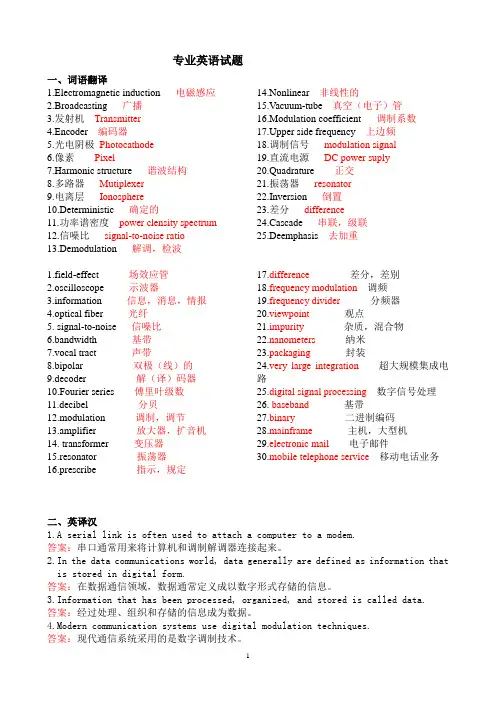
专业英语试题一、词语翻译1.Electromagnetic induction 电磁感应2.Broadcasting 广播3.发射机Transmitter4.Encoder 编码器5.光电阴极Photocathode6.像素Pixel7.Harmonic structure 谐波结构8.多路器Mutiplexer9.电离层Ionosphere10.Deterministic 确定的11.功率谱密度power clensity spectrum12.信噪比signal-to-noise ratio13.Demodulation 解调,检波14.Nonlinear 非线性的15.Vacuum-tube 真空(电子)管16.Modulation coefficient 调制系数17.Upper side frequency 上边频18.调制信号modulation signal19.直流电源DC power suply20.Quadrature 正交21.振荡器resonator22.Inversion 倒置23.差分difference24.Cascade 串联,级联25.Deemphasis 去加重1.field-effect 场效应管2.oscilloscope 示波器rmation 信息,消息,情报4.optical fiber 光纤5. signal-to-noise 信噪比6.bandwidth 基带7.vocal tract 声带8.bipolar 双极(线)的9.decoder 解(译)码器10.Fourier series 傅里叶级数11.decibel 分贝12.modulation 调制,调节13.amplifier 放大器,扩音机14. transformer 变压器15.resonator 振荡器16.prescribe 指示,规定17.difference差分,差别18.frequency modulation调频19.frequency divider分频器20.viewpoint 观点21.impurity杂质,混合物22.nanometers纳米23.packaging封装24.very large integration 超大规模集成电路25.digital signal processing数字信号处理26. baseband 基带27.binary二进制编码28.mainframe 主机,大型机29.electronic mail电子邮件30.mobile telephone service移动电话业务二、英译汉1.A serial link is often used to attach a computer to a modem.答案:串口通常用来将计算机和调制解调器连接起来。
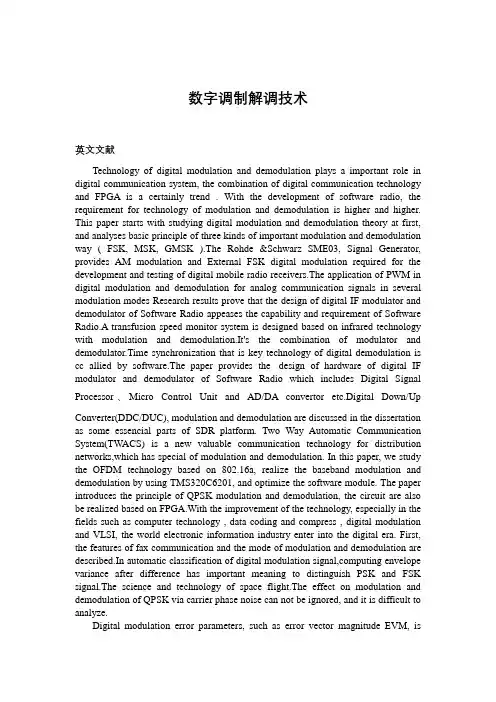
数字调制解调技术英文文献Technology of digital modulation and demodulation plays a important role in digital communication system, the combination of digital communication technology and FPGA is a certainly trend . With the development of software radio, the requirement for technology of modulation and demodulation is higher and higher. This paper starts with studying digital modulation and demodulation theory at first, and analyses basic principle of three kinds of important modulation and demodulation way ( FSK, MSK, GMSK ).The Rohde &Schwarz SME03, Signal Generator, provides AM modulation and External FSK digital modulation required for the development and testing of digital mobile radio receivers.The application of PWM in digital modulation and demodulation for analog communication signals in several modulation modes Research results prove that the design of digital IF modulator and demodulator of Software Radio appeases the capability and requirement of Software Radio.A transfusion speed monitor system is designed based on infrared technology with modulation and demodulation.It's the combination of modulator and demodulator.Time synchronization that is key technology of digital demodulation is cc allied by software.The paper provides the design of hardware of digital IF modulator and demodulator of Software Radio which includes Digital Signal Processor、Micro Control Unit and AD/DA convertor etc.Digital Down/Up Converter(DDC/DUC), modulation and demodulation are discussed in the dissertation as some essencial parts of SDR platform. Two Way Automatic Communication System(TWACS) is a new valuable communication technology for distribution networks,which has special of modulation and demodulation. In this paper, we study the OFDM technology based on 802.16a, realize the baseband modulation and demodulation by using TMS320C6201, and optimize the software module. The paper introduces the principle of QPSK modulation and demodulation, the circuit are also be realized based on FPGA.With the improvement of the technology, especially in the fields such as computer technology , data coding and compress , digital modulation and VLSI, the world electronic information industry enter into the digital era. First, the features of fax communication and the mode of modulation and demodulation are described.In automatic classification of digital modulation signal,computing envelope variance after difference has important meaning to distinguish PSK and FSK signal.The science and technology of space flight.The effect on modulation and demodulation of QPSK via carrier phase noise can not be ignored, and it is difficult to analyze.Digital modulation error parameters, such as error vector magnitude EVM, is important in test and measurement of information system. This paper introduces the technology research progress in the metrology of digital modulation error parameters. First, we point out the basic problems existing in the field, which is about traceability and parameter range of calibration, and describe the relevant research, such as the thinking and technology of the `RF waveform metrology'. Then, we highlight the research progress of our team: 1). The metrology method and system for digital demodulation error parameter based on CW combination, which fits BPSK, QPSK, 8PSK, 16QAM, 64QAM modulation: this method can achieve traceability and error setting ability in a wide range, when standard EvmRms is 1.585%, the expanded uncertainty (k=2) is 0.009%. 2). The metrology method and system for digitaldemodulation error parameter based on analog AM or PM. 3). The metrology method and system for digital demodulation error parameter based on IQ gain imbalance and phase imbalance. 4). The metrology method and system for digital demodulation error parameter based on analog PM in the aspect of GMSK and FSK modulation. 5). The metrology method and system for digital demodulation error parameter based on Baseband waveform design. Based on these methods, our proposal are given as follows: first, establish public metrology standard for digital modulation error parameters; second, develop a new type of instrument "vector signal analyzer calibrator".In this paper, we propose a novel method of chaotic modulation based on the combination of Chaotic Pulse Position Modulation (CPPM) and Chaotic Pulse WidthModulation (CPWM). This combination looks very promising for the improvement of information privacy in chaos-based digital communications. In the CPPM+CPWM method, each pulse is a chaotic symbol which carries binary information of two bits corresponding to its position and width, where the position is determined by the interval between rising edge of the current pulse compared to the previous one and the width is determined by the duration between the rising edge and the falling edge of the same pulse. This offers the increase of bit rate, bandwidth efficiency and privacy in comparison with the method of CPPM. The schemes of Modulation andDemodulation (MoDem) of CPPM+CPWM are proposed, designed and analyzed that based on the conventional schemes of CPPM. The numerical simulation in time domain of the system of CPPM+CPWM MoDem is implemented in Matlab/Simulink. It gives a summary of theoretical and practical studies on the properties of pulse-phase modulation, developed mainly in 1943. The properties of pulse-phasemodulation are studied by means of Fourier transformations. Although some approximations are introduced, the calculations lead to the following definite conclusions: (1) Pulse-phase modulation introduces no amplitude distortion except at sub-multiples of the recurrent frequency. (2) The harmonic distortion, if any, is negligible and this method of modulation can be used for high-quality broadcasting.(3) Pulse-phase modulation is subject to a special type of distortion called ?cross-distortion,? produced by side bands of the recurrent frequency appearing in the signal bandwidth. Curves of the approximate amount of this type of distortion are given, and it is shown that, in practical multi-channel systems, this distortion isnegligible, provided that the recurrent pulse frequency is at least double the highest signal frequency to be transmitted, and preferably equal to, or greater than, three times this frequency. This study is followed by considerations on the signal/noise ratio in pulse-phase modulation. Pulse-phasemodulation is compared with amplitude modulation and a formula, giving the improvement in the signal/noise ratio due to pulse-phase modulation, is established by very simple considerations. It is shown that this ratio improves as the frequency bandwidth used in pulse-phase modulation. It is shown how an improvement of 3 db in signal/noise ratio can be obtained by suppressing the noise on the synchronizing pulse, and a practical circuit developed and applied in 1943 by the author is described. Finally, a typical example of pulse technique is given. In practical circuits the modulator and demodulator pulses are not perfectly shaped, because of the departure from linearity due to finite time-constants. This introduces harmonic distortion. It is shown how this distortion can be practically elimi- nated by designing circuits so that the time constant is equal at modulationand demodulation.It present a novel technique for digital data modulation and demodulationcalled triangular modulation (TM). The modulation technique was developed primarily to maximize the amount of data sent over a limited bandwidth channel while still maintaining very good noise rejection and signal distortion performance. Themodulation technique involves breaking digital data into a series of parallel words. Each word is then represented by one half period of a triangular waveform whose slope is proportional to the value of the parallel word it represents. Thedemodulation technique for this uniquely defined waveform involves first digitizing the waveform at a higher constant sampling rate. A linear regression algorithm using the method of least squares is then used to compute the slope of the digitized waveform to a very high precision. This process is repeated for each rising and falling edge of the triangular modulated waveform. All encoded data is extracted by precise slope computation since each slope uniquely defines the encoded data word it represents. The ability of the demodulation algorithm to compute the exact slope of the modulated waveform determines how many bits can be represented by the modulated waveform. Transmission channel bandwidth limitations determine the allowable range of slopes used. Several simulations are performed to provide a sample of how the modulation method will perform in various real world environments. The paper also discusses several application areas where themodulation technique will provide superior results over other modulation methods.The theory of constant envelope orthogonal frequency division multiplexing (CE-OFDM) is analyzed in this paper, along with the introduction of the implementation method of CE-OFDM technique. Besides, the modulation and demodulation process is simulated and analyzed. And the results indicate that CE-OFDM conducts phasemodulation on the basis of OFDM modulation. Thus, FFT/IFFT is implemented in the transmitting and receiving terminals. Furthermore, the method of equalization applied in the demodulation process can optimize system performance. And also, CE-OFDM solves the problem of high peak-to-average power ratio (PAPR) in OFDM, reducing PAPR to 0Db.High efficient modulation technology is a hot research topic. UNB modulation, for its good performance, is paid to more attention. First, the article introduces EBPSK modulation scheme as UNB modulation method, gives its time and frequency domain characteristics and presents its optimized form in the same time, which can lower the sideband power level, while keeping the modulation information un-lost. Then, filter design is discussed about two zero and two pole digital filter, which shows narrower bandwidths and a fast response speed to the EBPSK based UNB modulated signals, although the filter bandwidth is much narrower, the modulationinformation still can be seen after the modulated signals filtered using it. Last, simulation is done about EBPSK based UNB modulation and demodulation, and experimental results show that EBPSK based UNB modulation has high bandwidth efficiency and a good, even better BER performance using the filters.中文译文数字调制解调技术在数字通信中占有非常重要的地位,数字通信技术与FPGA 的结合是现代通信系统发展的一个必然趋势。
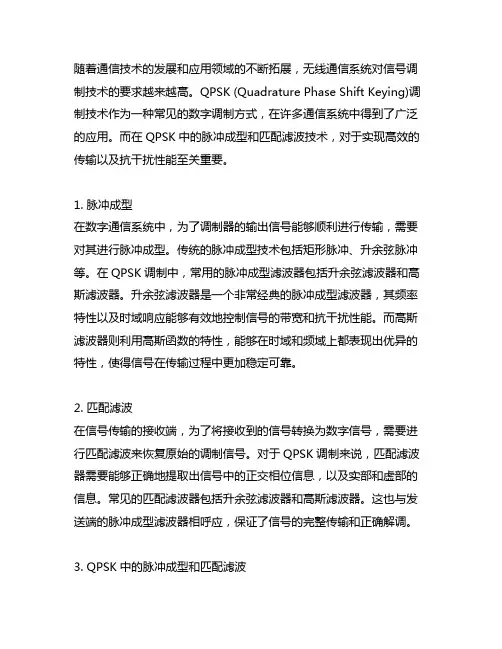
随着通信技术的发展和应用领域的不断拓展,无线通信系统对信号调制技术的要求越来越高。
QPSK (Quadrature Phase Shift Keying)调制技术作为一种常见的数字调制方式,在许多通信系统中得到了广泛的应用。
而在QPSK中的脉冲成型和匹配滤波技术,对于实现高效的传输以及抗干扰性能至关重要。
1. 脉冲成型在数字通信系统中,为了调制器的输出信号能够顺利进行传输,需要对其进行脉冲成型。
传统的脉冲成型技术包括矩形脉冲、升余弦脉冲等。
在QPSK调制中,常用的脉冲成型滤波器包括升余弦滤波器和高斯滤波器。
升余弦滤波器是一个非常经典的脉冲成型滤波器,其频率特性以及时域响应能够有效地控制信号的带宽和抗干扰性能。
而高斯滤波器则利用高斯函数的特性,能够在时域和频域上都表现出优异的特性,使得信号在传输过程中更加稳定可靠。
2. 匹配滤波在信号传输的接收端,为了将接收到的信号转换为数字信号,需要进行匹配滤波来恢复原始的调制信号。
对于QPSK调制来说,匹配滤波器需要能够正确地提取出信号中的正交相位信息,以及实部和虚部的信息。
常见的匹配滤波器包括升余弦滤波器和高斯滤波器。
这也与发送端的脉冲成型滤波器相呼应,保证了信号的完整传输和正确解调。
3. QPSK中的脉冲成型和匹配滤波在QPSK调制中,脉冲成型和匹配滤波是至关重要的环节。
通过合适的脉冲成型滤波器,可以保证发送信号在频域上的特性以及抗干扰性能;而在接收端,匹配滤波器能够高效地提取出所需的信息,实现对信号的完整解调。
QPSK中的脉冲成型和匹配滤波技术是数字通信系统中不可或缺的一环。
4. 应用领域QPSK调制的脉冲成型和匹配滤波技术在许多应用场景中得到了广泛的应用。
例如在无线通信系统中,QPSK调制可以有效地提高频谱效率,使得有限的频谱资源可以更加充分地利用。
在卫星通信系统中,QPSK调制的稳健性能使得信号能够更加稳定地在长距离传输过程中保持良好的特性。
在数字电视、无线局域网以及移动通信等领域,QPSK调制也都得到了广泛的应用。

数字信号调制的三种主要形式的英文
数字信号调制是数字通信中的重要组成部分。
数字信号调制可以将数字信号转换成模拟信号,方便在传输过程中进行处理和传输。
数字信号调制有三种主要形式,分别是ASK、FSK和PSK。
下面分别介绍这三种数字信号调制的英文表达。
1. ASK (Amplitude Shift Keying):振幅键控
ASK是一种将数字信号通过振幅的变化来传输的数字调制技术。
在ASK中,数字信号中的1和0分别对应着不同的振幅,通过改变振幅的大小来传输数字信号。
2. FSK (Frequency Shift Keying):频移键控
FSK是一种将数字信号通过频率的变化来传输的数字调制技术。
在FSK中,数字信号中的1和0分别对应着不同的频率,通过改变频率的大小来传输数字信号。
3. PSK (Phase Shift Keying):相位键控
PSK是一种将数字信号通过相位的变化来传输的数字调制技术。
在PSK中,数字信号中的1和0分别对应着不同的相位,通过改变相位的大小来传输数字信号。
以上就是数字信号调制的三种主要形式的英文表达。
了解这些英文表达有利于在国际交流中更好地表达和理解数字信号调制的相关
内容。
- 1 -。
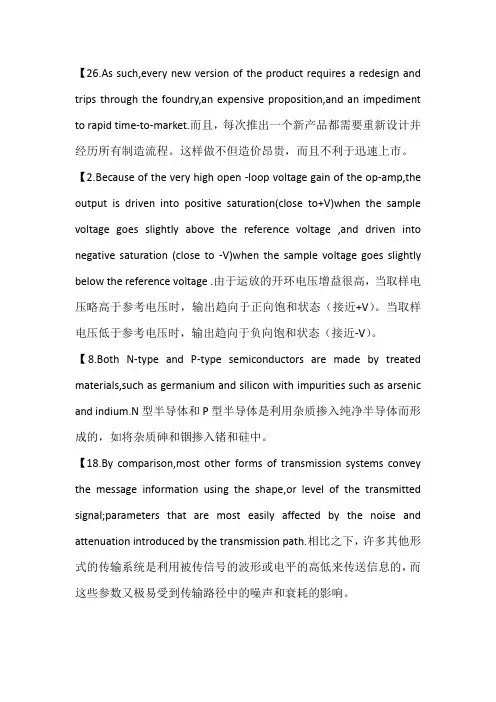
【26.As such,every new version of the product requires a redesign and trips through the foundry,an expensive proposition,and an impediment to rapid time-to-market.而且,每次推出一个新产品都需要重新设计并经历所有制造流程。
这样做不但造价昂贵,而且不利于迅速上市。
【2.Because of the very high open -loop voltage gain of the op-amp,the output is driven into positive saturation(close to+V)when the sample voltage goes slightly above the reference voltage ,and driven into negative saturation (close to -V)when the sample voltage goes slightly below the reference voltage .由于运放的开环电压增益很高,当取样电压略高于参考电压时,输出趋向于正向饱和状态(接近+V)。
当取样电压低于参考电压时,输出趋向于负向饱和状态(接近-V)。
【8.Both N-type and P-type semiconductors are made by treated materials,such as germanium and silicon with impurities such as arsenic and indium.N型半导体和P型半导体是利用杂质掺入纯净半导体而形成的,如将杂质砷和铟掺入锗和硅中。
【18.By comparison,most other forms of transmission systems convey the message information using the shape,or level of the transmitted signal;parameters that are most easily affected by the noise and attenuation introduced by the transmission path.相比之下,许多其他形式的传输系统是利用被传信号的波形或电平的高低来传送信息的,而这些参数又极易受到传输路径中的噪声和衰耗的影响。
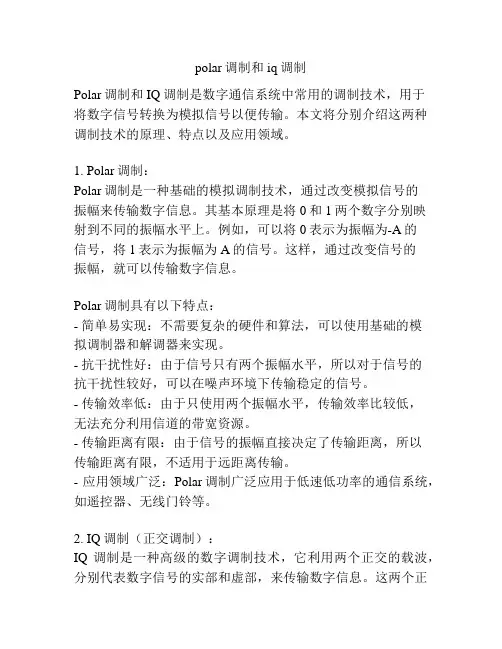
polar调制和iq调制Polar调制和IQ调制是数字通信系统中常用的调制技术,用于将数字信号转换为模拟信号以便传输。
本文将分别介绍这两种调制技术的原理、特点以及应用领域。
1. Polar调制:Polar调制是一种基础的模拟调制技术,通过改变模拟信号的振幅来传输数字信息。
其基本原理是将0和1两个数字分别映射到不同的振幅水平上。
例如,可以将0表示为振幅为-A的信号,将1表示为振幅为A的信号。
这样,通过改变信号的振幅,就可以传输数字信息。
Polar调制具有以下特点:- 简单易实现:不需要复杂的硬件和算法,可以使用基础的模拟调制器和解调器来实现。
- 抗干扰性好:由于信号只有两个振幅水平,所以对于信号的抗干扰性较好,可以在噪声环境下传输稳定的信号。
- 传输效率低:由于只使用两个振幅水平,传输效率比较低,无法充分利用信道的带宽资源。
- 传输距离有限:由于信号的振幅直接决定了传输距离,所以传输距离有限,不适用于远距离传输。
- 应用领域广泛:Polar调制广泛应用于低速低功率的通信系统,如遥控器、无线门铃等。
2. IQ调制(正交调制):IQ调制是一种高级的数字调制技术,它利用两个正交的载波,分别代表数字信号的实部和虚部,来传输数字信息。
这两个正交信号可以分别表示为I路信号和Q路信号,通过相位调制来传输数字信息。
例如,在QPSK调制中,通过调整正交载波的相位可以表示4个不同的数字。
IQ调制具有以下特点:- 高传输效率:由于利用两个正交信号,可以在相同的带宽上传输更多的数字信息,提高传输效率。
- 传输距离长:由于采用数字调制方式,可以通过增加功率和使用错误纠正码等技术来延长传输距离。
- 抗干扰性强:正交信号可以在同一频带上传输,并且由于正交性质,可以降低信号间的干扰。
- 复杂度高:IQ调制需要复杂的硬件和算法实现,对于低成本和低功耗的应用不太适用。
- 应用领域多样:IQ调制在高速通信系统中应用广泛,如无线局域网(Wi-Fi)、移动通信(4G、5G)等。

现代通信系统中的PAM调制1. 引言现代通信系统中,PAM调制(Pulse Amplitude Modulation,脉冲幅度调制)是一种常用的调制技术。
本文将深入探讨现代通信系统中PAM调制的原理、应用及其在Matlab第三版中的实现。
2. PAM调制原理PAM调制是一种模拟调制技术,其原理是将模拟信号通过取样和量化的方式转换为离散的脉冲信号。
在PAM调制中,调制信号的幅度被用来表示模拟信号的大小,脉冲的宽度则表示取样的间隔。
PAM调制是数字信号和模拟信号之间的桥梁,常用于数字通信系统中。
3. PAM调制在现代通信系统中的应用PAM调制在现代通信系统中有着广泛的应用,特别是在数字通信领域。
它可以用于传输语音、视频和数据等信息,并且在噪声较小的环境下具有很好的传输性能。
另外,PAM调制还可以与其他调制方式如PCM(Pulse Code Modulation,脉冲编码调制)相结合,实现更高效的信号传输。
4. Matlab第三版中的PAM调制实现在Matlab第三版中,PAM调制可以通过编程实现。
用户可以利用Matlab提供的函数和工具,编写程序实现PAM调制的仿真和分析。
通过Matlab第三版,用户可以更直观地理解PAM调制的原理和性能,并且可以通过仿真实验来验证理论分析的结果。
5. 个人观点和理解对于PAM调制,我个人认为它在数字通信系统中具有重要的地位。
它不仅可以实现模拟信号和数字信号之间的转换,还可以在传输中对信号进行多种处理,提高了通信系统的稳定性和可靠性。
在Matlab第三版中,通过对PAM调制的仿真实现,可以更深入地理解其原理和应用,为学习和研究提供了极大的便利。
6. 总结与回顾通过本文的探讨,我们对现代通信系统中PAM调制的原理、应用及在Matlab第三版中的实现有了更加全面的了解。
PAM调制作为数字通信系统中的重要调制技术,将在未来的通信领域中发挥着更加重要的作用。
本文总字数超过3000字,详细探讨了现代通信系统中PAM调制的相关内容,并结合个人观点进行了阐述。
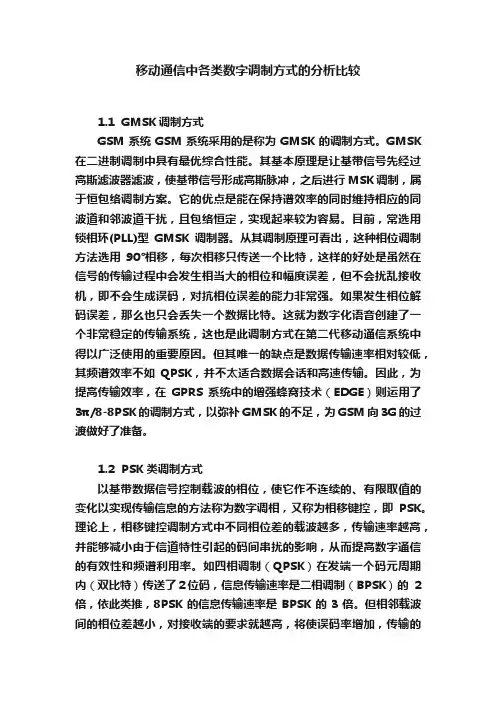
移动通信中各类数字调制方式的分析比较1.1 GMSK调制方式GSM系统GSM系统采用的是称为GMSK的调制方式。
GMSK 在二进制调制中具有最优综合性能。
其基本原理是让基带信号先经过高斯滤波器滤波,使基带信号形成高斯脉冲,之后进行MSK调制,属于恒包络调制方案。
它的优点是能在保持谱效率的同时维持相应的同波道和邻波道干扰,且包络恒定,实现起来较为容易。
目前,常选用锁相环(PLL)型GMSK调制器。
从其调制原理可看出,这种相位调制方法选用90°相移,每次相移只传送一个比特,这样的好处是虽然在信号的传输过程中会发生相当大的相位和幅度误差,但不会扰乱接收机,即不会生成误码,对抗相位误差的能力非常强。
如果发生相位解码误差,那么也只会丢失一个数据比特。
这就为数字化语音创建了一个非常稳定的传输系统,这也是此调制方式在第二代移动通信系统中得以广泛使用的重要原因。
但其唯一的缺点是数据传输速率相对较低,其频谱效率不如QPSK,并不太适合数据会话和高速传输。
因此,为提高传输效率,在GPRS系统中的增强蜂窝技术(EDGE)则运用了3π/8-8PSK的调制方式,以弥补GMSK的不足,为GSM向3G的过渡做好了准备。
1.2 PSK 类调制方式以基带数据信号控制载波的相位,使它作不连续的、有限取值的变化以实现传输信息的方法称为数字调相,又称为相移键控,即PSK。
理论上,相移键控调制方式中不同相位差的载波越多,传输速率越高,并能够减小由于信道特性引起的码间串扰的影响,从而提高数字通信的有效性和频谱利用率。
如四相调制(QPSK)在发端一个码元周期内(双比特)传送了2位码,信息传输速率是二相调制(BPSK)的2倍,依此类推,8PSK的信息传输速率是BPSK的3倍。
但相邻载波间的相位差越小,对接收端的要求就越高,将使误码率增加,传输的可靠性将随之降低。
为了实现两者的统一,各通信系统纷纷采用改进的PSK调制方式,而实际上各类改进型都是在最基本的BPSK和QPSK基础上发展起来的。
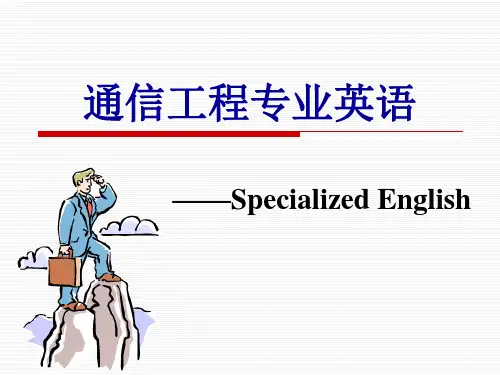
调制技术调制技术是把基带信号变换成传输信号的技术。
它将模拟信号抽样量化后,以二进制数字信号“1”或“0”对光载波进行通断调制,并进行脉冲编码(PCM)。
数字调制的优点是抗干扰能力强,中继时噪声及色散的影响不积累,因此可实现长距离传输。
它的缺点是需要较宽的频带,设备也复杂。
基带信号是原始的电信号,一般是指基本的信号波形,在数字通信中则指相应的电脉冲。
在无线遥测遥控系统和无线电技术中调制就是用基带信号控制高频载波的参数(振幅、频率和相位),使这些参数随基带信号变化。
用来控制高频载波参数的基带信号称为调制信号。
未调制的高频电振荡称为载波(可以是正弦波,也可以是非正弦波,如方波、脉冲序列等)。
被调制信号调制过的高频电振荡称为已调波或已调信号。
已调信号通过信道传送到接收端,在接收端经解调后恢复成原始基带信号。
解调是调制的反变换,是从已调波中提取调制信号的过程。
在无线电通信中常采用双重调制。
第一步用数字信号或模拟信号去调制第一个载波(称为副载波)。
或在多路通信中用调制技术实现多路复用(频分多路复用和时分多路复用)。
第二步用已调副载波或多路复用信号再调制一个公共载波,以便进行无线电传输。
第二步调制称为二次调制。
用基带信号调制高频载波,在无线电传输中可以减小天线尺寸,并便于远距离传输。
应用调制技术,还能提高信号的抗干扰能力。
调制方式调制方式按照调制信号的性质分为模拟调制和数字调制两类;按照载波的形式分为连续波调制和脉冲调制两类。
模拟调制有调幅(AM)、调频(FM)和调相(PM)。
数字调制有振幅键控(ASK)、移频键控(FSK)、移相键控(PSK)和差分移相键控 (DPSK)等。
脉冲调制有脉幅调制(PAM)、脉宽调制(PDM)、脉频调制(PFM)、脉位调制(PPM)、脉码调制(PCM)和增量调制(ΔM)。
示出常用调制方式的已调波形。
调制方式特性按照传输特性,调制方式又可分为线性调制和非线性调制。
广义的线性调制,是指已调波中被调参数随调制信号成线性变化的调制过程。
Unit 4 通信和信息论Unit 4-1第一部分:远程通信远程通信是远距离通信的信号传输,在现代,通常这个过程需要电子发射机发射电磁波,但是在早期远程通信包括使用烟火信号,鼓或旗语或日光仪。
今天,远程通信很普遍的,助推这一过程的设备如电视,无线电和电话在世界的许多地区都已很普遍。
还有连接这些设备的许多网络,包括计算机网络,公共电话网,无线电网和电视网络。
互联网上的计算机通信是众多通信的一个例子。
通信系统通常由通信工程师设计。
在这个领域中早期的发明家有Alexander Graham Bell, Guglielmo Marconi 和John Logie Baird。
通信在当今的世界经济发展中起着举足轻重的作用,通信产业的税收在世界总产值的比例已接近百分之三。
基本要素每个通信系统包括三个基本要素:采集信息并能将其转换为信号的发射机,传输信号的传输媒介,接收信号并能将其还原为有用信息的接收机。
考虑一个无线电广播的例子。
广播塔是发射机,收音机是接收机,传输媒介是自由空间。
通常通信系统都是双向的,一个设备既做发射机又做接收机,即收发器。
例如,移动手机就是一个收发器。
电话线上的通信称为点对点通信,因为只在一个发射机和一个接收机之间。
通过无线电广播的通信称为广播(一对多)通信,因为通信是在一个大功率的发射机和许多接收机之间。
模拟或数字信号可以是模拟的,也可以是数字的。
在模拟信号中,信号根据信息而连续变化。
在数字信号信息被编码为一组离散值(如,1和0)。
在传输过程中,模拟信号中的信息会因噪声而退化。
相反,只要噪声不超过一定的阈值,数字信号中的信息是不会丢失的。
这是数字信号相对于模拟信号一个关键的优点。
网络网络是由一个相互通信的发射机、接收机或收发机的集合。
数字网络由一个或多个路由器组成,路由器正确地将数据发送给用户。
模拟网路由一个或多个交换器组成,交换器在两个或多个用户间建立连接。
这两种网络都需要中继器,用于远距离传输时的放大或重建信号。
单元二1、对模拟信号的传输的数字方法的使用在电讯系统中变得普遍。
有2个原因可以解释这个现象。
第一,如果传输的是数字信号而不是模拟信号,那么系统几乎不受影响只要噪声电平不高于它的门限电平。
事实是因为,对于长距离传输,数字信号可以再再生器中重新生成,从而产生一个新的、无噪声的信号。
并且,只要噪声在一个可比较的模拟系统中,噪声就不会积累。
第二、一个数字系统的成分非常适合执行大规模集成电路(LSI)。
2、即使在这样一个数字传输系统中,但是,被处理的信号在本质上通常是模拟的。
有多种调制手段以实现这种转换,包括脉宽调制PWM、脉幅调制PAM以及脉码调制PCM。
在数字电讯系统中,脉码调制是当前最普遍使用的调制系统。
脉码调制信号是通过取样、量化和编译模拟信号产生。
这个结果是二进制数字的一个系列,即在信号中高低电平的交替。
这个系列可以被运用在频率调制中。
3.对模拟电压V(t)采样过程包括生成一个脉冲串,在这个脉冲串中,第n个脉冲的幅度等于V(t)在t=nT时的幅值。
为了使脉冲串独特地限制V(t)中所包含的信息量,取样速率fc=1/T必须至少是V(t)的光谱中高频成分的2倍大,然后在取样信号中脉冲幅值被量化,并且被转换为一组比特,称之为码组。
4. 在实际的PCM长途通信系统中经常利用时分复用方式来传输码字。
在TDM系统中,来自几个信道的码字交错着在一条线路上传输。
在音频(电话)系统中,通常将24或32路话路复用到一对线路中传输。
国际电报电话咨询委员会(CCITT)建议两个主要的架构(“层次”),现在许多全国性的PCM传输网络的使用。
在这种体系中,输入复用器将32路信息码交插在一起。
其中30路码字代表30路语音信道,其余2路时隙包含随路信令和同步码。
第二种体系由图2所示,主要用在美国、加拿大和日本。
在这种系统中,24路语音信号在输入端复用在一起。
5. 传输包括把数字编码的语音信号从一个地方发送到另一个地方,而交换包括建立两个话音信道的有效连接,这两个信道是(用来)承载数字信号的。
PCM and Digital Transmission1.Introduction1>Motivations for the use of PCM and digital transmissionThis process of converting an analogue wave form such as that of telephone speech to a digital form inevitably involves an increase in bandwidth or in the frequency spectrum occupied in the medium being used and would appear at first to be a rather pointless complication of the process of conveying voice signals . The technical and economic advantages will be explained in following sections but a brief initial outline may help to put things in perspective.2> The Quest for Time Division MultiplexingFor many years there have been attempts to realize the economic potentialities of time division of time division multiplexing (TDM) .It is by no means a new concept and was used in telegraphy before telegraphy came on the scene .The devices used were simply synchronized commutators where one at the sending end “sampled” each of a number of individual channels in sequence and transmitted the samples in sequence .The other devices at the receiving end received the samples and distributed them in the correct sequence to the corresponding individual channels. Obviously there was a problem of maintaining the commutators in synchronism. This problem remains but modern electronic methods have provided cheap and reliable ways of achieving the required result.Where, as in telegraphy, the information is digital, i.e. comprises a succession of units of information limited to a very few discrete values, e.g. the binary mark and space of telegraphy ,TDM is extremely simple and cheap.It has long been known that an analogue wave form of limited bandwidth restricted to an upper frequency limited of f1may be accurately conveyed by 2f1. If these samples are transmitted as narrow pulses, then the pluses corresponding to several channels may be sent consecutively in a regular cycle and it thus becomes feasible to apply TDM to analogue information.This form of TDM has been used for transmission purpose and also for switching ,and various modulation techniques have been employed : for instance pulses amplitude ,pluses width and pulses position .In switching ,where the samples can be transmitted over wide band high ways, reasonable control of signal impairments can be achieved but on junction and truck routes the inevitable distortion of the pulses in amplitude and phase make it very difficult to control inter-channel interface or crosstalk without prohibitively costly equalizing .It was partly in this quest for a more satisfactory answer to the TDM problem and partly to counter the high noise levels of earlier radio links that the late Alec Reeves over 30 years ago conceived the idea of PCM in which an analogue wave is sampled at regular intervals by narrow pluses and a numerical “description”of the amplitude of each sample is transmitted in place of the analogue wave form.Although originally conceived against the background of noisy radio links,the first large scale commercial use of PCM has been on cable pairs .Theeconomic importance of increasing the capacity of the vast quantities of copper parts now installed on short-and medium-haul routes has long been recognized .The relatively poor crosstalk and noise characteristics of these pairs has proved a major obstacle to the introduction of multiplexing by traditional FDM methods .With PCM it has proved practicable as will be explained in the following sections ,to use two regular cable pairs to handle from 24 to 32 conversations. The contribution of PCM to the low quality radio link has not been ignored and not long ago the inventor was honoured in the USA in recognition of the use PCM to transmit Mariner IV’s TV pictures 200 000 000 miles back from Mars to our planet.3> Noise Cancelling Aspects of Digital TransmissionThe conversion of analogue information to a binary digital form of coding introduces a new range of opportunity and problems. The key to the attractions of digital transmission resides in the concept of regeneration. In classical analogue communication system the limiting factor in the establishing of a satisfactory connection between two remote users is the signal/noise ratio. Modern methods have established very satisfactory standards in regard to the limiting of attenuations of the signal, but no analogue amplifier can prevent the inevitable accumulation of noise. Each time the signal is amplified so also is the noise which has been added to it within the pass band involved.The characteristic of digital transmission is that since has a restricted number of states (typically for binary data only two) then provided the acquired noise on any section does not exceed the level at which ambiguities (errors) will occur in recognizing which state was transmitted, the signal may be regenerated without error and noise is not accumulated. This is true in regard to all essential characteristic of the signal except for a residual form of noise known as phase or timing jitter, i.e. the varying displacement in time of the pulses from their ideal isochronous positions.This ability of regeneration to avoid almost all noise accumulation results in the signal/noise ratio required on each section to reduce regeneration interpretation errors to a negligible quantity being much lower than an analogue system could tolerate on a complete connection. This means that the wider frequency spectrum requirements of the digital mode are more than counterbalanced (certainly on enclosed media) by the vastly improved noise and interference tolerance. This is an example of exchanging bandwidth for signal/noise ratio.4> Time Switching and MultiplexingA further aspect of the “ruggedness”of PCM is that the flexibility of TDM, particularly in regard to switching but also in such operation as through group patching and multiplex reorganization is greatly enhanced by the ability to store the transmitted information for very short periods in order to perform “slot changing.”This aspect will be analyzed in detail later. The point to be stressed here is both expensive and unreliable. Binary storage is on the other hand the foundation of all computer techn ology and is cheap, simple and reliable.5>Application to Uses Other Than TelephonyThe process of digitizing analogue information is not confined to voice signals but been extensively explored in regard to music, video, facsimile and other forms of intelligence. For some of these forms long distance transmission by analogue methods can present problems of phase equalization to a degree which does not apply to voice signals and in regard to them the digital mode has added attractions.It may seem inconsistent to claim for PCM methods a relief from problems of phase equalization and at the same time admit concern about build-up of phase jitter in digital systems. The point is that phase errors in an analogue mode, like other forms of noise and distortion cannot be identified and eliminated. In the digital mode phase jitter is identifiable and can be reduced to whatever degree is needed.There is, finally, a rapidly growing demand for transmission of data and for higher speed telegraphy. Here the network is dealing with information in the required binary form and the basic attractions of a digital network are self evident.6> Move to Comprehensive Digital NetworksThe earlier section of what follow deal with the application of digital transmission to voice signals and other analogue information. Later there is examination of the greatly increased attraction in regard both to performance and to cost of complete networks with all transmission and switching operating in the digital mode so that analogue/digital conversion and its inverse occur only at terminals and all intervening operations are performed on the digital form of the information. This concept is more far-reaching in its consequence than might at first be supposed. It means that the peculiar characteristics of variant types of information and the special problems associated with them can be confined to the terminal conversion areas. The central transmission network operations remain basically the same for all types of information, except of course for the variations in digital rate needed. The flexibility of TDM allows these variations to be accommodated cheaply and simply and even admits of reorganization of the patterns of usage as terminal conversion techniques change or new modes of usage arise. The only significant reservation in this connection is the possibility that different types of information will present different demands in regard to error rate and phase jitter. As will be indicated later even these problems admit of some degree of adsorption into the terminal conversion areas.These factors add up to some very considerable advantages for this mode of communication and account for the rapid advances in technology and scale of application over the last decade or so.2.Theoretical Considerations of PCM1>IntroductionAny practical communication system must be a compromise between the requirements for high quality and low cost. The frequency spectrum will be limited by the bandwidth which can be made available and there must be varyingdegrees of cumulative distortion and noise. PCM cannot eliminate the transmission degradations but it does reduce and simplify them by confining them essentially to considerations of digital error rate and timing or phase jitter. This state of affairs is attained by acceptance of certain impairments introduced at the terminal analogue/digital and digital /analogue conversion processes. It is necessary to start by an examination of these impairments and the steps which have to be taken to hold them to a subjectively satisfactory level. It must be emphasized that the subjective aspects are very important and vary from one type of information to another, for instance as between speech and television. This section examines the problem mainly in relation to speech.It is impossible in one short section to treat the theory in any depth. For more detailed examination the reader should such volumes as Cattermole’s. What will be attempted here is to indicate the nature of the issues involved and the ways in which an acceptable code of practice is being established.2> Essential Elements of Terminal conversionThe essential elements involved in the terminal process are: sampling, quantizing, companding and coding. The last is inescapably involved with desired characteristics of digital transmission which will be dealt with further in subsequent sections. Some reference is needed here, however it also involved with the practical implementation of quantizing and companding.Most of that which follows is relevant to the basic process of digitizing a signal voice channel and the need for this will probably arise. It should be remembered, however, that nearly all system in use to data are multiplex systems and these processes of sampling, quantizing and coding and their receiving counterparts are conducted sequentially by a common unit serving a number of voice channels. This sequential operation unit is then the essential basic of the multiplexing process.(1)SamplingPCM represents in many ways the culmination of a long search for effective methods of employing time division multiplexing in the handing of analogue information. The basic of all such approaches is the idea of periodic sampling and PCM shares with all the earlier attempts the inherent limitations.The first limitation is the relationship of the bandwidth or more accurately the upper limit of the spectrum to the sampling rate. The theory that a wave form limited to an upper frequency f may be completely conveyed by sampling at a rate of 2f is obviously as it stands theoretical idealism. It pre-supposes infinitely short sampling periods, a signal of infinite duration and perfect filters. The first of these issues is relatively unimportant and the distortion due to a sampling period of finite but practically feasible duration, for example 2 or 3% of the sampling rate, is quite negligible.The other considerations are of practical importance. A signal such as speech is in its essential nature a succession of short duration periods of transmitted power with little or no sustained repetition, and filters are necessarily imperfect, especially if they are to be simple and cheap.Determination of a practical compromiser for a sampling rate to handle voice signals over the 300~3400HZ spectrum now firmly established for telephony involves, therefore, some examination of the limitations of practicable methods of sampling and counterpart of demodulating and filtering, together with some consideration of subjective issues concerning the tolerance of voice communication to particular classes of distortion.A value of 8000 samples per second has received world-wide agreement and is now one of the solidly established parameters.(2)QuantizingThe next problem to be examined is that of the distortion arising from the fundamental requirement of PCM that samples transmitted cannot be continuously variable but must be chosen from a finite set, the number of which is a function of the length of the binary number we are prepared to assign for the transmission of each sample.(3)CompandingOne of the major problems of practical PCM is the very wide range of power levels to be handled. The range within the speech of one speaker is some 25 dB and if to this is added differences between loud and quiet talkers and the attenuation of established connections before a PCM link is encountered we are faced with a need to handle a range of some 60dB. If the lowest level to be handled just exceeds one step and peak clipping is reasonably limited then this 60dB on a uniform step basis would involve about ±1000 levels.(4)CodingCoding, that is the expression of a quantized sample magnitude in terms of a binary number for transmission over the channel, may be executed in many ways. The main categories may be described as:Parallel codingSequential codingCounting.In briefly describing these coding methods certain restraints on the choice of code which may be imposed by some line system will be ignored and we will assume freedom to transmit any binary number.。
数字通信1 引言在本书中,我们将介绍作为数字通信系统分析和设计基础的基本原理。
数字通信的研究主题包括数字形式的信息从产生该信息的信源到一个或多个目的地的传输问题。
在通信系统的分析和设计中,特别重要的是信息传输所通过的物理信道的特征。
信道的特征-般会影响通信系统基本组成部分的设计。
下面阐述一个通信系统的基本组成部分及其功能。
1.1数字通信系统的基本组成部分图1.1 显示了一个数字通信系统的功能性框图和基本组成部分。
输出的可以是模拟信号,如音频或视频信号;也可以是数字信号,如电传机的输出,该信号在时间上是离散的,并且只有有限个输出字符。
在数字通信系统中,由信源产生的消息变换成二进制数字序列。
理论上,应当用尽可能少的二进制数字表示信源输出(消息)。
换句话说.我们要寻求一种信源输出的有效的表示方法,使其很少产生或不产生冗余。
将模拟或数宇信源的输出有效地变换成二进制数字序列的处理过程称为信源编码或数据压缩。
由信源编码器输出的二进制数字序列称为信息序列,它被传送到信道编码器。
信道编码器的目的是在二进制信息序列中以受控的方式引人一些冗余,以便于在接收机中用来克服信号在信道中传输时所遭受的噪声和干扰的影响。
因此,所增加的冗余是用来提高接收数据的可靠性以及改善接收信号的逼真度的。
实际上,信息序列中的冗余有助于接收机译出期望的信息序列。
例如,二进制信息序列的一种(平凡的)形式的编码就是将每个二进制数字简单重复m次.这里m为一个正整数。
更复杂的(不平凡的)编码涉及到一次取k个信息比特,并将毎个k比特序列映射成惟一的n比特序列,该序列称为码字。
以这种方式对数据编码所引人的冗余度的大小是由比率n/k作来度擞的。
该比率的倒数,即k/n,称为码的速率或简称码率。
信道编码器输出的二进制序列送至数宇调制器,它是通信信道的接口。
因为在实际中遇到的几乎所有的通信信道都能够传输电信号(波形),所以数字调制的主要目的是将二进制信息序列映射成信号波形。
引言这个应用笔记介绍了数字解调的概念在如今许多通信系统中的应用。
重点放在解释那些设计用来提高系统效率的设备。
大多数通信系统涉及到这三个类别之一:带宽效率、电源效率和成本效益。
带宽效率定义为一个调制方案将数据投放到有限的带宽上的能力。
电源效率定义为通信系统在最低的实际功率下可靠地发送信息的水平。
在大多数通信系统中,带宽效率放在很重要的位置上。
要优化的参数取决于特定系统的要求,可以在下面两个例子见。
对于地面数字微波无线电的设计者来说,最重要的是优秀的带宽效率同是具有低的比特错误率。
他们有足够的电源以供使用不用去担心电源效率。
他们并不太关心接受者的费用或者容易程度因为他们不必建立庞大的数量。
另一方面,手持蜂窝电话设计人员重视电源效率因为这些手机需要用电池运行。
费用也同样放在很重要的位置因为蜂窝手机必须用低费用去吸引更多的消费者。
所以,这些通信系统牺牲一些带宽效率去提高电源效率和降低成本。
每当这些关于效率的参数(带宽、电源和成本)其中之一增加的时候,另一个也会随之减少,或者变得更加复杂也可能在不好的环境下不能很好地工作。
成本费用是系统中的重中之重。
低成本无线电总是被需要的。
在过去,通过牺牲电源和带宽效率来减低无线电成本是可能的。
而如今情况已经改变了。
无线电频谱是非常有价值的,而那些不能很好地运用频谱效率的设备将会没有市场或者在竞争中被新产品所代替。
这些权衡因素必须在数字射频通信系统设计中考虑清楚。
应用笔记介绍:•用于移动数字调制的原因;•信息如何调制到同相和正交信号上;•不同种类的数字调制;•过滤技术来节省带宽;•在数字调制信号中的方法;•复用技术用于共享传输信道;•数字信道以及接受者如何工作;•数字射频通信系统的测量;•重要的数字通信系统的关键规格概述表;•应用在数字射频系统中的一个术语表这些概念在任何通信系统的建构中均存在。
如果你明白了这些结构,那么你就能够明白现在或者未来的任何通信系统如何工作。
第一章为什们进行数字调制移动数字调制提供了赋予更多信息的能力,更适合于数字数据服务,更高的数据安全性,更好品质的通信系统以及更快的系统可用性。
通信系统的发展有以下几方面限制因素:• 可用的带宽• 可用功率• 系统的固有噪声电平射频频谱必须共享,然而随着通信系统服务的增长每天都有更多的用户需求频谱。
数字调制方案与模拟调制方案相比有更大的能力去传送更多的信息。
1.1折衷的简单性以及带宽这是一个设备复杂度与信息带宽间的折衷在通信系统中,简单的硬件可用于在发射机和接收机之间的信息交流,然而,这用到了许多频谱,频谱限制了用户的数量。
另外,更复杂的发射器和接收器可以用于发射同样的信息在更少的带宽内。
过渡到越来越高的频谱效率的发射技术需要越来越复杂的硬件设备。
复杂的硬件设备是难以设计、测试和建造的。
折衷存在于通信系统之中,无论这个系统是通过线或者空气,模拟或者数字的方式。
图1 设备复杂度与信息带宽间的折衷1.2行业发展趋势在过去的几年中,一种主要的转变发生在从简单的模拟AM、FM、PM调制到新型的数字调制技术。
数字调制包括:• QPSK (四相相移键控)• FSK (频移键控)• MSK (最小移频键控)• QAM (正交振幅调制)在许多新的通信系统中,复杂性的另一个层面是多路复用。
两种主要类型的多路复用是TDMA (时分多址) 和CDMA (码分多址)。
有两种不同的方式去增加信号的多样性允许不同的信号被彼此分离。
图2 行业的发展趋势2.1 发送信息通过空气去发送信息,主要通过三大步骤1 让一种纯净的载体形成发送端2 把信息调制到这个载体上发送出去。
任何能够可靠地观察到的信息参数特征变化都能承载信息3 在接收端,信息的变化被观测后解调。
图3 发送信息(数字或者模拟)2.2信号能被改变的参数特征信号只有三中参数特征始终可以被改变:幅度、相位和频率。
然而,相位和频率只是通过不同的方式去观测同样的信号变化图4信号可以改变的参数特征在AM调制中,高频载波信号的幅值被改变与调制信号瞬间幅值成比例符合。
频率调制(FM)是当今通信系统下最被广泛应用的模拟调制技术。
在FM调制下,载波信号的幅值保持为常数,然而它的频率却随着调制信号而发生改变。
幅度和相位可以同时分别进行调制,但是这很难做到,更难以观测到。
所以,在实际的通信系统中,信号被分离成另一种独立的部分:I信号(同相信号)和Q信号(正交信号)。
这两部分彼此成正交关系并且不容易互相干扰。
2.3极坐标图——同时显示幅度和相位极坐标图能够方便的同时观察到幅度和相位。
以载波的频率和相位作为参考值并且与信号相关的被改变。
信号的幅度和相位可以在极坐标图中观察到。
在通信系统中的载波,相位是一个值得参考的数,同样,幅度也绝对是一个值得参考的数值。
两者同样应用于数字通信系统中。
极坐标图是数字通信当中多重显示的基础,尽管它常常通过直角坐标的同步信号和正交信号用于描述信号的向量。
图5 极坐标图同时显示相位和幅度2.4信号的变化在极坐标图中的表示这些表格展现了不同的调制方法在极坐标图中的不同形态。
幅度调制之后向量和中心位置会有一段距离,相位调制后会有一段角度形成。
信号调制时的变化幅度调制(AM)只改变信号的幅度。
相位调制(PM)也只改变信号的相位幅度调制和相位调制可以同时进行。
频率调制(FM)看上去和相位调制十分相似,尽管它改变的变量是频率而不是相位。
通过一个简单的幅度调制系统可以看出射频系统设计中一个具体的难点。
在幅度调制中产生不相关的角度调制之后,在极坐标图观察到的结果是一条直线。
这条直线从原点到某一峰值或者振幅值。
然而,在实际情况中这条线并不是笔直的。
幅度调制经常带来一些不想要的小幅相位调制。
结果就得到了一条弯曲的线。
如果在系统传送过程中有一些延迟,这条线也可能变成一条环状曲线。
在任何会改变幅度的调制中,这样的失真都是不可避免的。
因此,在一个系统中幅度调制的有效程度会对畸变函数有影响。
2.5 同相信号、正交信号的形式在数字通信系统中,调制通常通过同相信号和正交信号来表示。
这是一个用矩形表示的极坐标图。
在极坐标图中,I轴位于零度的位置,Q轴位于90度的位置。
信号矢量在I轴的投影是信号的同相部分,在Q轴的投影是正交部分。
图7 I-Q图标2.6在无线发送端的I、Q信号I/Q图表的形式是非常有实际价值的,因为它可以反映出大多数数字信号是通过I、Q调制器产生的这种方式。
在发送端,I信号和Q信号通过相同的本地振荡器相加而成。
一个90度的角度调节器放在本地振荡器的一条线路上。
被90度分离的信号就形成了我们所知道的相互正交信号,这样的正交信号不会出现互相干扰的现象。
他们是信号的两个相互独立的组成部分。
当再次向相加时,他们就组成了一个混合的输出信号。
这两路相互独立的I、Q信号都可以通过简单的电路完成发送和接受的功能。
I、Q调制的这种方法主要优点体现在融合相互对称的独立信号形成一个混合的信号,并且在之后把这个混合信号分离成相互独立的信号图8 IQ信号在实际无线电发射系统中2.7在无线接收端的I、Q信号这个带有幅度和相位信息的混合信号输入到达接收端。
这个输入信号和本地振荡器通过两路不同频率的载波相融合。
一路是任意的零相位。
另一路是有90度的相位变化。
这个(有相位和幅度调制组成的)混合的输入信号被分离成同相信号部分和正交信号部分。
这两路信号是相互独立并且相互正交的。
其中一个变化并不会影响到另一个。
通常情况下,信号不能再极坐标的形式绘制出来,也不能没有把极坐标形式转化成直角坐标形式之前为它的矩形形状做出更多的阐释。
这种极坐标到直角坐标的转换正是I、Q信号在无线数字端相加的过程。
一个本地振荡器、角度调节器和两个加法器可以有效并且准确的完成这种转换。
图9 在接收端的IQ信号2.8为什么要用I、Q信号的方法通过I、Q调制器可以很轻松地完成数字调制。
大多数数字调制系统在I、Q平面上映射出许多个离散点。
这就是我们所说的星座图。
当信号从一点移动到另一点时,幅度和相位调制同时产生。
要去完成这种幅度和相位同时进行调制的调制器是十分难以做到的。
这对常用的相位调制器来说是不可能做到的。
理论上来说,需要无限相移的能力才能让信号从原点开始沿着一个方向形成一个圆。
另外,I、Q调制器可以轻松地完成AM调制和PM调制同时进行。
I、Q方式控制的信号是是有界限的,然而可以通过恰当的I、Q信号相位调制形成无限圆的相位调制。
第3章不同的数字调制方法和相对效率这一章包括了主要的数字调制方式,他们的主要应用、相对频谱效率以及主要的调制方式在实际应用中的一些改变。
幸运的是,构成任何系统的调制模块是有限的。
3.1应用这个表格包括了无线通信系统和视频通信系统中不同的调制方式的具体应用。
调制方式应用MSK,GMSK GSM,CDPDBPSK 远空遥测,光缆调制QPSK, π/4 DQPSK 卫星,CDMA,NADC,TETRA,PHS,PDS,LMDS,DVB-S,光缆,光缆调制,TFTS OQPSK CDMA,卫星FSK,GFSK DECT,RAM移动数据,AMPS,CT2,ERMES,陆地移动,公共安全8,16VSB 北美数字电视,广播,光缆8PSK 卫星,航空,遥测飞行员监控宽带视频系统16QAM 数字微波调制,调制解调器,DVB-S,DVB-T32QAM 地面微波,DVB-T64QAM DVB-C,调制解调器,宽带机顶盒,MMDS256QAM 调制解调器,DVB-C,数字视频尽管这份笔记重点放在无线通信中,出于完整性的考虑视频应用也在这份表格中列出,并且因为他们和其他的无线通信系统有着相同之处。
3.1.1比特率和符号率为了去理解并且比较不同调制方式的效率,首先去理解比特率和符号率的不同是十分重要的。
通信系统信道中信号带宽需要参考的符号率而不是比特率。
比特率=符号率÷数每个传送符号的比特位比特率是一个系统比特流的频率。
比如,通过一个8比特的抽样器发射无线电,在10kHz对噪音进行抽样。
比特率,这个无线电基本的比特流速率,将要以8比特乘以每秒10千的抽样频率,或者80kbits 每秒。
图10是QPSK信号的一个状态图,这个状态可以从0映射到1.这是一种常见的映射,但不是唯一的一种。
任何映射都可以被用到。
图10 比特率和符号率符号率是比特率除以每个传送符号的比特位数。
如果每个传送符号都是一比特,那么符号率和比特率都将是80kbits每秒。
如果每个传送符号是两比特,那么符号率将会是比特率的一半就是40kbits每秒。
符号率同时也叫做波特率。
注意,波特率和比特率是不同的,这里常出现概念的混淆。
如果每个传送符号能带有更多的比特位,那么同样的数据能够在更少的频带中发送。
这就是为什么那些更复杂、使用更多数量状态的调制可以再更少的射频频带上传送信息。